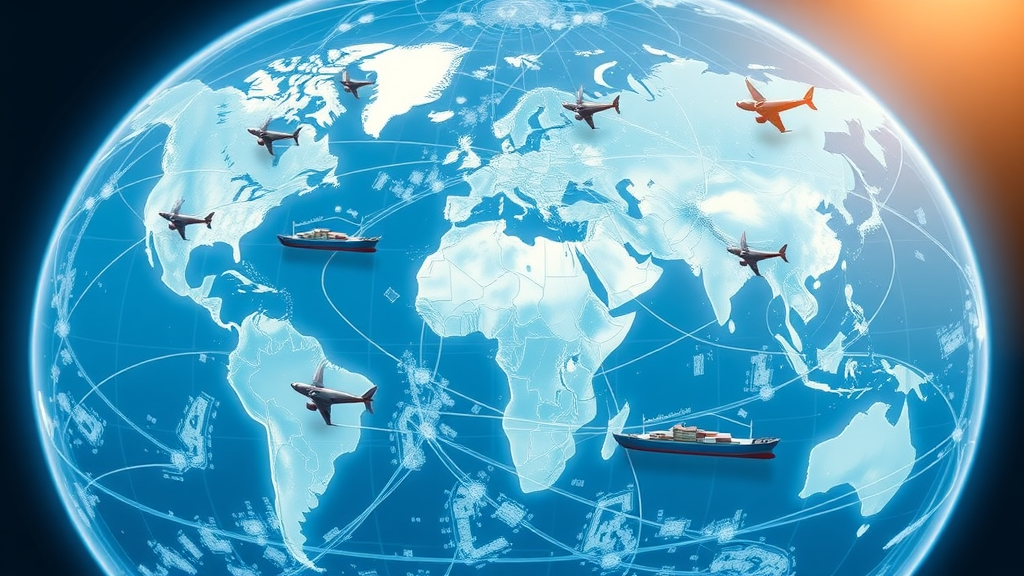Did you know that over $1.7 billion in fines are imposed on companies each year for violating trade regulations? This staggering figure highlights a reality— understanding global trade laws is now essential for any business entering or expanding in international markets. With rules constantly evolving and penalties soaring, even a minor compliance misstep can put your entire global strategy at risk. In this essential guide, you’ll uncover what trade regulations mean for your business, read real-world examples, and find actionable steps to stay ahead and avoid common pitfalls.
- Did you know that over $1.7 billion in fines are imposed annually for violating trade regulations? Learn how awareness and compliance can protect your company in global trade.

Uncovering Trade Regulations: Why Understanding Global Trade Laws Saves Your Business
Navigating the complex landscape of trade regulations is more critical than ever, especially as international trade grows and the rules become more intricate. Every business involved in the import and export of goods and services must understand the regulatory policies put forward by both home and foreign governments. These trade laws exist not only to facilitate commerce but also to ensure fair competition, protect sensitive information, and guarantee the safety of imported goods. Failing to comply—intentionally or inadvertently—can result in severe fines, reputational damage, and even loss of access to key markets.
Whether you run a small business in the United States shipping products to Europe, or a global corporation managing supply chains across continents, being aware of the code of federal regulations and global trade requirements is non-negotiable. Compliance officers increasingly rely on digital solutions, industry forums, and expert advisors to track new laws, interpret official government organization standards, and implement best practices tailored to their company’s needs. With shifting policies in areas such as intellectual property rights, customs duties, and export controls, proactive awareness can be the difference between opportunity and disaster in the global market .

Defining Trade Regulations: What You Need to Know
Trade Regulation Explained: Scope and Key Provisions
At its core, trade regulation consists of the legal frameworks and governmental policies that guide the cross-border exchange of goods and services . They ensure orderly transactions, set boundaries for acceptable business conduct, and provide mechanisms for resolving disputes among trading partners. Key elements include import and export restrictions, licensing, customs inspections, and the enforcement of technical standards at the border. Major regulatory bodies such as the Department of Commerce in the United States, the World Trade Organization (WTO), and specific agencies within the European Union oversee the implementation of these rules on a global scale.
The impact of trade regulations extends to businesses of all sizes. Large multinationals manage extensive compliance teams to navigate numerous jurisdictions, but even small and midsize exporters can face stiff penalties for missing a regulatory update. As tariffs, quotas, and embargoes shift in response to political or economic pressures, companies must develop adaptive compliance programs that prioritize up-to-date training, monitoring, and audit systems.
- Key elements of trade regulations
- Regulatory bodies overseeing global trade
- How trade regulation impacts businesses of all sizes
What do you mean by trade regulation?
Trade regulation refers to the legal rules and government policies that direct and control the movement of goods and services across borders, ensuring fair and secure foreign trade. These regulations cover everything from import/export licensing and tariff schedules to intellectual property protections and trade sanctions . The goal is to create a transparent, balanced playing field in the global trade environment, shielding domestic markets from unfair practices while encouraging open commerce and international cooperation.
- Trade regulation refers to the legal rules and government policies that direct and control the movement of goods and services across borders, ensuring fair and secure foreign trade.

Core Global Trade Regulations and Examples in Practice
Examples of Trade Regulations in Global Trade
Regulations for global trade come in many forms, each designed to address specific risks or opportunities within a dynamic international landscape. Among the most influential are import and export restrictions —rules that limit what can cross national borders for reasons of health, security, or economic advantage. Customs duties (or tariffs) impose taxes on specific imported goods to level the competitive playing field for domestic industries or generate government revenue. Trade sanctions can target specific countries or entities to enforce foreign policy goals, often by restricting access to technology, capital, or sensitive information.
In addition, technical standards ensure that products entering a country meet local safety, quality, and labeling requirements. These standards protect both consumers and industries, but navigating them can be a challenge for companies new to a region. For example, the United States may place export controls on technology with military applications, while the European Union enforces strict environmental compliance for electronics. A failure to comply with these regulatory requirements can result in delayed shipments, product recalls, or bans from lucrative foreign markets.
- Import and export restrictions
- Customs duties
- Trade sanctions
- Technical standards
What are the examples of trade regulations?
Some common examples include tariffs on imported electronics that protect domestic manufacturers, export controls that restrict the sharing of sensitive technology, quotas setting limits on annual textile imports, and embargoes that prohibit trade with nations under international sanctions such as those imposed by the United Nations . Each example illustrates how governments may tailor trade laws to address security, economic development, or public safety concerns within their territory.
- Some examples include tariffs on electronics, export controls on sensitive technologies, quotas on textile imports, and embargoes on certain countries.

Trade Policy and Trade Regulations: How They Shape International Business
Trade Policy vs Trade Regulations
| Trade Policy | Trade Regulations | |
|---|---|---|
| Objectives | Strategic economic goals | Legal compliance requirements |
| Nature | Broad guidelines | Specific laws |
| Examples | Free trade agreements | Customs procedures |
Understanding the difference between trade policy and trade regulations is crucial for international business. Trade policy sets the overarching framework—a government's strategic approach to how it wants to interact with the global market, including which countries it prefers open relations with and where it seeks to protect domestic industries. Trade regulations , in contrast, translate these intentions into practical requirements—such as licensing forms, tariffs, product safety checks—enforced by various federal agencies in each country.
For example, a government may adopt a policy to promote free trade with specific nations (trade policy), but the regulations implemented may specify how customs inspections are handled or what paperwork needs to accompany each shipment (trade regulations). Businesses must track both—policy shifts can signal new opportunities, while regulatory changes define what’s operationally required for legal compliance.
What is the trade policy and regulations?
- Trade policy outlines a government’s approach to international trade, while trade regulations are the enforceable laws that realize these policies in practice.
At a practical level, this means companies engaging in international trade must constantly watch both the high-level direction of government policy and the fine detail of the regulations that implement these policies. This dual awareness helps organizations avoid misunderstandings and missteps—ensuring they don’t just strategize for global success, but also secure the legal right to enter new markets and avoid enforcement actions.
Key Compliance Programs: Meeting Code of Federal Regulations and Foreign Trade Obligations
Building an Effective Compliance Program for Import and Export
The foundation of trade regulation compliance is an effective internal compliance program. This program must start by identifying which parts of the code of federal regulations and other national or international rules apply to your specific products and trade routes. Companies should develop clear procedures for monitoring changing laws, deliver regular training to staff, and utilize auditing tools to ensure ongoing compliance. Collaboration between compliance managers, logistics partners, and legal advisors is often required to address complex cross-border issues such as handling restricted goods or navigating dual-use export controls.
An effective compliance program brings together cross-functional teams—legal, finance, logistics, and executive management—to ensure a comprehensive view of regulatory requirements. Failure to meet these obligations doesn’t just risk monetary penalties; it can result in restricted access to domestic and international markets and costly delays. Investing in digital tracking tools, leveraging official government organization resources, and joining industry forums can help streamline compliance efforts.
- Identifying applicable code of federal regulations
- Implementing monitoring and training
- Auditing compliance activities
How do you regulate trade?
- Governments regulate trade through licensing, inspection, setting tariffs, and enforcing the code of federal regulations to ensure fair global trade practices.
The federal government and allied agencies deploy multiple mechanisms to regulate trade: issuing import/export licenses, inspecting shipments at borders, collecting duties or tariffs, and using digital recordkeeping—often tying these procedures directly to the code of federal regulations . Regular audits and enforcement by agencies such as U.S. Customs and Border Protection or Export Enforcement units contribute to a culture of compliance. For businesses, proactively engaging with regulatory bodies and using resources such as the official website of the Department of Commerce or the federal register can make all the difference.

Trade Agreements: Central Pillars of Global Trade Regulations
Understanding Major Trade Agreements and Their Effects
Trade agreements are powerful tools that shape the contours of global commerce. Agreements like the North American Free Trade Agreement (NAFTA) , the World Trade Organization (WTO) accords , and a range of bilateral and multilateral pacts lower barriers, harmonize standards, and set dispute resolution frameworks among member nations. These agreements underpin how customs procedures, tariffs, and mutual recognition of regulations operate, providing predictability and security for businesses engaged in international trade .
The effect of a trade agreement is felt in everyday transactions: reduced paperwork for certain products, lower duty rates, or shared customs data to combat fraud. For companies trading across these agreements, understanding their provisions and adapting compliance programs accordingly is essential to maximizing savings and minimizing risk. Staying informed about ongoing negotiations and recent entries into force—such as updates to NAFTA now known as USMCA—ensures that organizations remain agile and competitive in the global market.
- North American Free Trade Agreement (NAFTA)
- World Trade Organization (WTO) accords
- Bilateral and multilateral trade agreements
"Trade regulations are the backbone of predictable and secure international markets."

Best Practices for Navigating International Trade Laws and Federal Regulations
Top Strategies for Ensuring Compliance in Trade Regulation
Staying compliant with trade regulations demands a proactive and coordinated approach—one that goes far beyond simply ticking boxes. Leading organizations conduct regular compliance audits to find and address gaps, invest in staff training, and regularly review their compliance program to ensure it aligns with evolving federal regulations . By doing so, businesses not only minimize legal and financial risks—they unlock new opportunities by building stronger relationships with supply chain partners and regulatory agencies across their target markets.
Industry leaders also stress the importance of collaboration—both internally among departments and externally with customs brokers, legal counsel, and trade experts . Participating in industry compliance forums gives companies insight into regulatory changes, case studies, and enforcement trends. Keeping pace with updates from sources such as the federal register , government websites , and international organizations is essential for compliant global operations.
- Conduct regular compliance audits
- Stay informed on regulatory changes
- Collaborate with trade experts
- Join industry compliance forums
FAQs: Common Questions About Trade Regulations
- What is trade law? Trade law is the body of law and agreements that govern commerce between nations. It encompasses both national legislation and international treaties, defining the rules for importing, exporting, and handling disputes between parties in the global trade ecosystem.
- What are trade barriers? Trade barriers are government-imposed limitations on the movement of goods and services across borders. These can include tariffs, quotas, import licenses, or outright bans meant to protect domestic industries or achieve foreign policy objectives.
- How do trade sanctions work? Trade sanctions are restrictive measures imposed by one country or group of countries against another to influence diplomatic, security, or economic outcomes. Sanctions may prohibit exports to or imports from targeted nations, restrict financial transactions, or freeze assets in the pursuit of specific policy goals.
- Why is compliance so important in foreign trade? Compliance is essential because failing to follow trade regulations can result in severe fines, shipment delays, loss of export privileges, and irreparable damage to your reputation. It protects your business from legal pitfalls and unlocks smoother access to international markets.
Stay Ahead: Next Steps for Mastering Trade Regulations
Key Takeaways for Success in Global Trade
- Know your trade regulations inside out
- Regularly update compliance programs and training
- Monitor the latest trade agreements
- Collaborate with legal counsel for global trade
"Vigilance in trade regulation saves millions—ignorance costs billions."

Ready to Protect Your Business from Trade Regulation Mistakes?
- Review your current compliance program
- Consult a trade law expert
- Call Global Trade News at 203 271 7991 to stay informed and proactive regarding trade regulations
Video: How Global Trade Compliance Prevents Legal Pitfalls
Watch our expert interview explaining real-world examples of compliance missteps—and how prompt action avoids multi-million dollar fines. Learn from the best in the business and ensure your organization is always prepared.
Video: Step-by-Step Guide to Navigating Import and Export Trade Regulations
This tutorial walks you through the essential steps for complying with import and export trade regulations. From choosing the right codes to completing customs documentation, you'll discover tips and resources for avoiding common errors.
Conclusion: Take action now—review your compliance program, keep abreast of regulatory changes, and consult with global trade experts to shield your business from costly mistakes.
For those looking to deepen their understanding of compliance and practical steps for success, exploring a comprehensive guide to starting an import-export business can provide actionable insights on building a strong foundation and navigating regulatory requirements from day one.
Mastering trade regulations is just the beginning of your journey toward global business excellence. To truly stay ahead, it’s essential to keep pace with evolving industry trends and best practices. Discover how leading organizations monitor global trade shifts and leverage up-to-date intelligence by visiting our resource on staying updated with global trade trends . This next step will empower you to anticipate changes, adapt your strategies, and unlock new opportunities in the ever-changing world of international commerce.
Understanding and adhering to trade regulations is crucial for businesses engaged in international commerce. To deepen your knowledge, consider exploring the following resources:
-
“Export Administration Regulations” : This resource provides comprehensive information on U.S. export guidelines and prohibitions, detailing the scope, applicability, and exceptions of the regulations. ( en.wikipedia.org )
-
“Non-tariff barriers to trade” : This article explains various non-tariff measures that can restrict imports or exports, such as import licensing, customs valuation rules, and technical barriers, offering insights into how these can impact international trade. ( en.wikipedia.org )
By reviewing these resources, you can gain a more nuanced understanding of trade regulations and their implications for your business operations.
 Add Row
Add Row  Add
Add 




 Add Row
Add Row  Add
Add 

Write A Comment